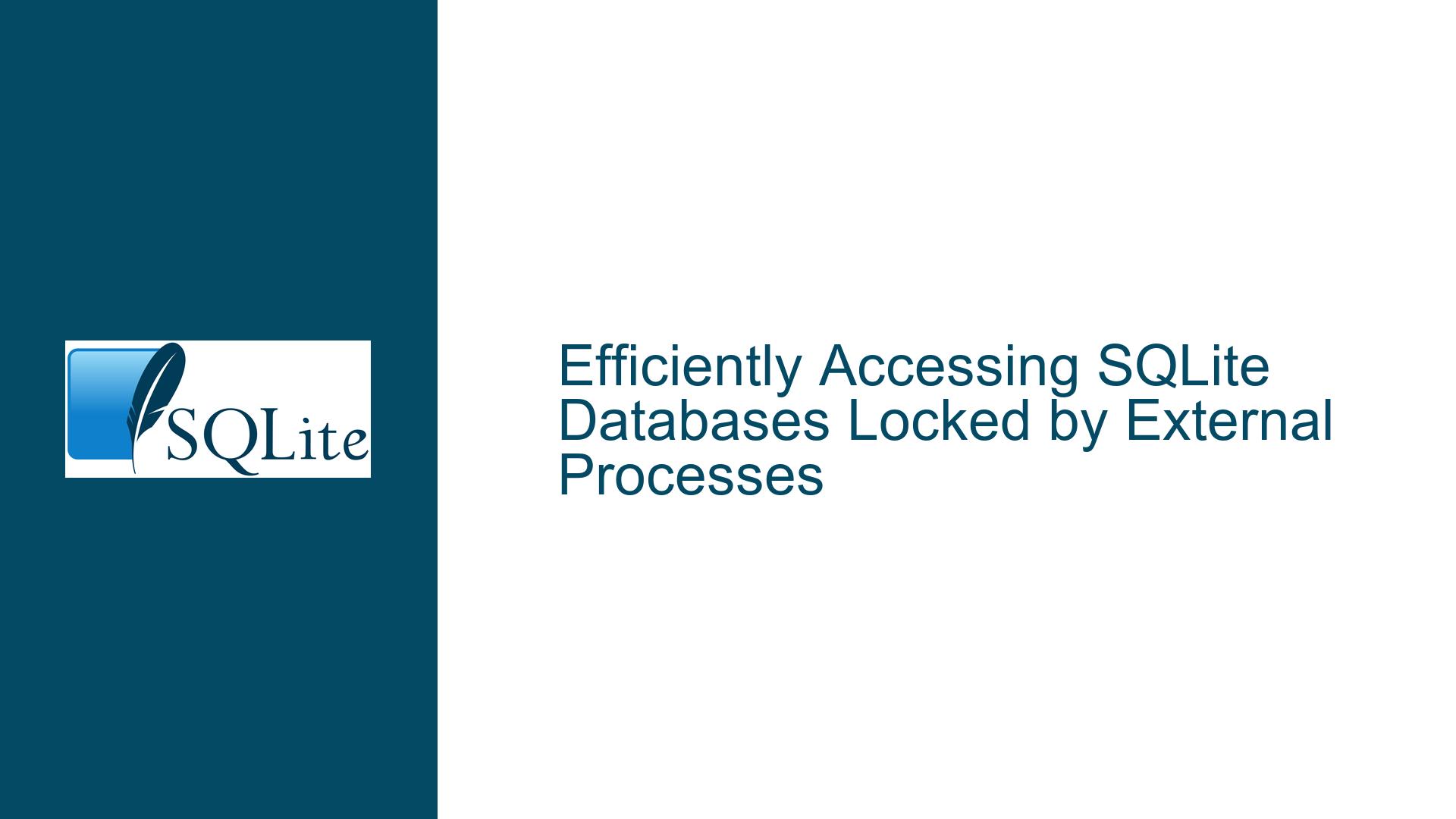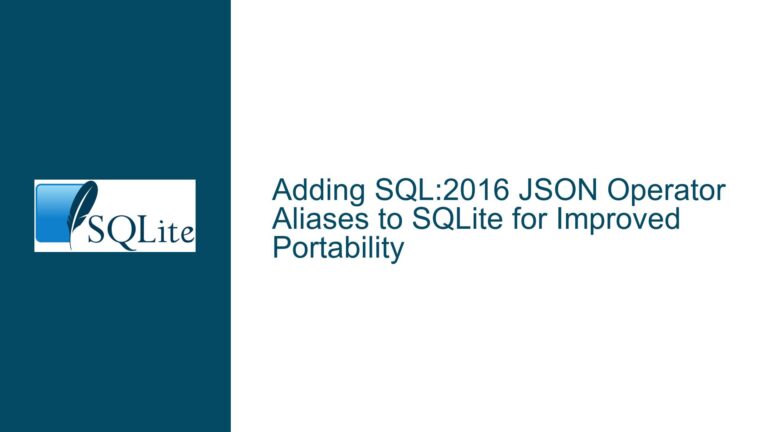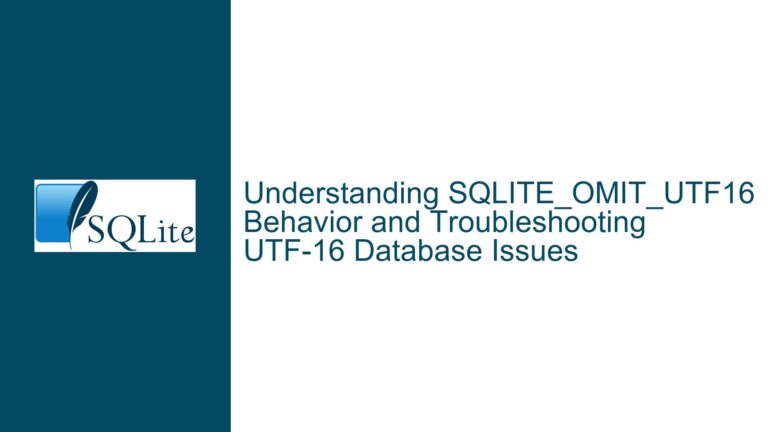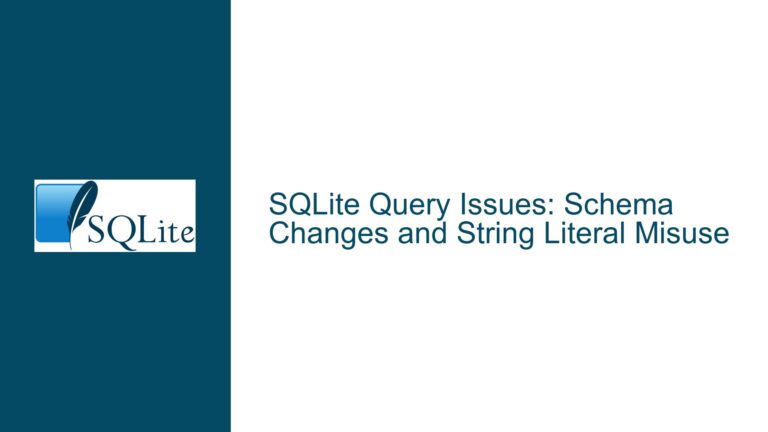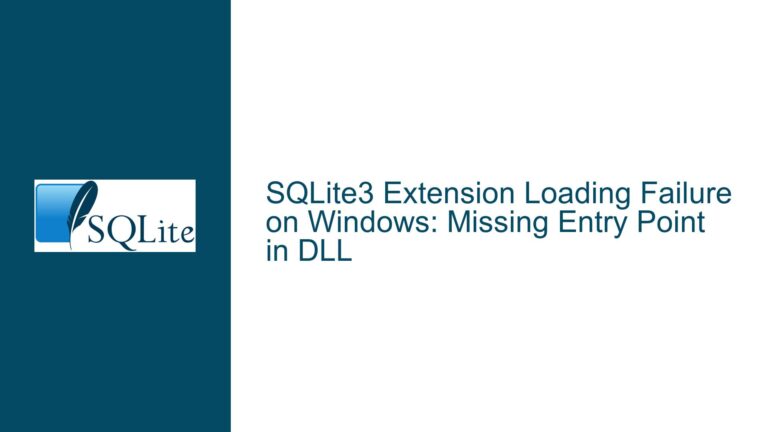Efficiently Accessing SQLite Databases Locked by External Processes
Issue Overview: In-Memory Database Access with External Process Locking
When working with SQLite databases, a common challenge arises when an external process holds an exclusive lock on the database file, preventing other processes from reading it directly. This scenario often forces developers to create temporary copies of the database file to bypass the lock. However, this approach introduces significant latency due to file I/O operations. The original discussion revolves around a user’s attempt to eliminate this latency by loading the database into memory directly, avoiding physical file duplication. The core technical challenge lies in safely accessing a database that is actively modified by an external process while ensuring data consistency and minimizing overhead.
SQLite’s architecture relies on file locks to coordinate concurrent access. When a process holds an exclusive lock (e.g., during a write transaction), other processes cannot read the database until the lock is released. Copying the file while it is locked risks capturing an inconsistent state, as the database might be mid-transaction. The user’s proposed solution—loading the database into memory—requires mechanisms to deserialize the database efficiently while mitigating the risks of data corruption.
Key technical components involved include:
- SQLite’s Serialize/Deserialize APIs: These allow converting a database into a byte stream and reconstructing it in memory.
- Locking Mechanisms: Understanding how SQLite uses file locks to manage transactions.
- Data Consistency: Ensuring that the in-memory copy reflects a transactionally consistent state despite concurrent modifications.
Possible Causes: Risks of In-Memory Database Copies and Lock Contention
1. Incomplete Transaction States During File Copy
SQLite guarantees atomic transactions through its journaling system. When a process writes to the database, it first updates a rollback journal or write-ahead log (WAL) before modifying the main database file. Copying the database file while a transaction is in progress can result in a snapshot that includes partially applied changes. For example:
- Page-Level Modifications: A transaction may update multiple database pages. If the copy operation captures some updated pages but not others, the in-memory database will reference inconsistent page linkages (e.g., B-tree structures pointing to nonexistent pages).
- Metadata Corruption: The
sqlite_mastertable (storing schema definitions) might be updated mid-copy, leading to missing tables or indexes in the copied database.
2. Locking Mechanism Bypass
SQLite’s locking protocol ensures that readers see a consistent database state by coordinating with writers. By bypassing these locks (e.g., via brute-force file copying), the copying process violates the protocol, risking:
- Read-Write Conflicts: The external process might modify the database while it is being copied, leading to phantom reads or torn pages.
- File System Caching Artifacts: File systems may cache portions of the database file, causing the copy operation to retrieve stale or mixed data.
3. Serialization/Deserialization Limitations
The sqlite3_serialize and sqlite3_deserialize APIs provide a controlled way to load databases into memory. However, their usage is constrained by:
- Compilation Flags: These APIs require SQLite to be compiled with
SQLITE_ENABLE_DESERIALIZE, which is not enabled by default in older versions. - Memory Allocation: Deserialized databases must use memory from SQLite’s allocator to support resizing, complicating integration with certain language bindings (e.g., Go’s
mattn/go-sqlite3).
4. External Process Behavior
The external process holding the exclusive lock may:
- Use Long-Running Transactions: Prolonged locks increase the window for inconsistent copies.
- Employ Specific Journal Modes: If the external process uses rollback journal mode (default), readers are blocked during writes. In WAL mode, readers can coexist with writers, but this depends on the external process’s configuration.
Troubleshooting Steps, Solutions & Fixes: Balancing Speed and Consistency
Step 1: Evaluate Data Consistency Requirements
Before proceeding, determine the tolerance for stale or inconsistent data:
- Append-Only Workloads: If the database is append-only (e.g., logging), the risk of corruption is lower, as new data is added sequentially. However, B-tree page splits can still lead to inconsistencies.
- Latency Tolerance: If occasional missed records are acceptable, prioritize speed. Otherwise, prioritize consistency.
Step 2: Use SQLite’s Built-in Serialization APIs
If the external process releases locks intermittently, use sqlite3_serialize to capture a consistent snapshot:
// C API Example
sqlite3 *src_db;
sqlite3_open("source.db", &src_db);
unsigned char *data = sqlite3_serialize(src_db, "main", &sz, SQLITE_SERIALIZE_NOCOPY);
sqlite3_close(src_db);
sqlite3 *mem_db;
sqlite3_deserialize(mem_db, "main", data, sz, sz, SQLITE_DESERIALIZE_FREEONCLOSE);
Advantages:
- Captures a transactionally consistent snapshot if the source database is readable.
- Avoids file system overhead.
Limitations:
- Requires a brief window where the external process releases its lock.
- Not supported by all language bindings (e.g., Go’s
mattn/go-sqlite3lacks this as of 2023).
Step 3: Optimize File Copy Operations
If serialization is unavailable, optimize file copying:
- Use a RAM Disk: Copy the database to a memory-backed filesystem (e.g.,
/dev/shmon Linux) to reduce I/O latency. - Leverage Copy-on-Write (CoW): On filesystems supporting CoW (e.g., Btrfs, ZFS), creating file snapshots can be near-instantaneous.
Step 4: Mitigate Corruption Risks
If direct copying is unavoidable, implement safeguards:
- Checksum Verification: Compute a checksum of the copied database and compare it with a known good state.
- SQLite Integrity Check: Run
PRAGMA integrity_checkon the copied database to detect corruption.
-- Example integrity check
PRAGMA integrity_check;
- Retry Mechanisms: If corruption is detected, retry the copy operation after a delay.
Step 5: Advocate for External Process Modifications
If the external process is under your organization’s control:
- Enable WAL Mode: This allows concurrent reads and writes, eliminating the need for copies.
PRAGMA journal_mode=WAL;
- Publish Snapshots: Modify the external process to periodically export a transactionally consistent copy of the database.
Step 6: Custom Language Binding Extensions
For unsupported APIs like sqlite3_deserialize in Go:
- Extend the Binding: Add native support for serialization/deserialization by modifying the binding’s C code.
- Use CGO: Directly invoke SQLite’s C functions via CGO.
// Go Example with CGO
/*
#include <sqlite3.h>
#include <stdlib.h>
*/
import "C"
import "unsafe"
func DeserializeDB(path string) (*sql.DB, error) {
var db *C.sqlite3
C.sqlite3_open_v2(C.CString(":memory:"), &db, C.SQLITE_OPEN_READWRITE, nil)
var data *C.uchar
var sz C.sqlite3_int64
// Implement custom serialization logic here
return sql.Open("sqlite3", ":memory:")
}
Step 7: Monitor External Process Behavior
Use tools like lsof or inotify to detect when the external process releases its lock:
# Linux example: Monitor file locks
lsof /path/to/database.db
Time your copy or serialization operations to coincide with lock release events.
Step 8: Benchmark and Iterate
Measure the performance and reliability of each approach:
- Latency: Compare the time taken for in-memory deserialization vs. file copying.
- Corruption Rate: Track how often copied databases fail integrity checks.
Final Recommendations
- Prioritize Serialization APIs: If possible, use
sqlite3_serializeduring brief unlock windows for consistent snapshots. - Fallback to RAM Disk Copies: When serialization is unavailable, optimize file copies using memory-backed storage.
- Implement Corruption Safeguards: Always validate copied databases before use.
- Collaborate with External Process Owners: Advocate for WAL mode or snapshot exports to resolve the root issue.
By systematically addressing the interplay between SQLite’s locking mechanisms, serialization APIs, and file system optimizations, developers can achieve low-latency access to locked databases while minimizing the risk of data inconsistency.
